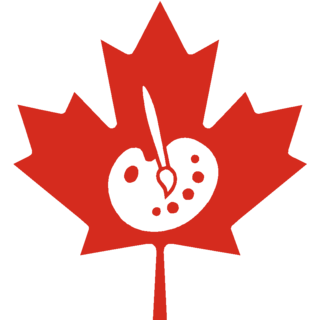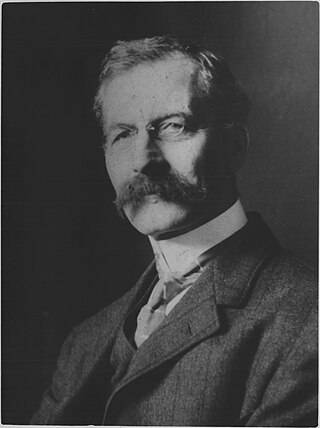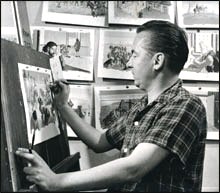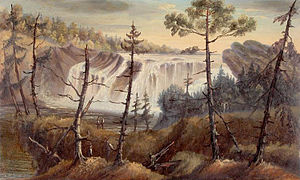
Cornelius David Krieghoff was a Dutch-born Canadian-American painter of the 19th century. He is best known for his paintings of Canadian genre scenes involving landscapes and outdoor life, which were as sought after in his own time as they are today. He painted many winter scenes, some in several variants.

Paul-Émile Borduas was a Québecois artist known for his abstract paintings. He was the leader of the avant-garde Automatiste movement and the chief author of the Refus Global manifesto of 1948. Borduas had a profound impact on the development of the arts and of thought, both in the province of Quebec and in Canada.

Jean-Paul Riopelle, was a Canadian painter and sculptor from Quebec. He had one of the longest and most important international careers of the sixteen signatories of the Refus Global, the 1948 manifesto that announced the Quebecois artistic community's refusal of clericalism and provincialism. He is best known for his abstract painting style, in particular his "mosaic" works of the 1950s when he famously abandoned the paintbrush, using only a palette knife to apply paint to canvas, giving his works a distinctive sculptural quality. He became the first Canadian painter since James Wilson Morrice to attain widespread international recognition and high praise, both during his career and after his death. He was a leading artist of French Lyrical Abstraction.

Marc-Aurèle de Foy Suzor-Coté was a French Canadian painter and sculptor. He was one of the first native-born Canadian artists whose works were directly influenced by French Impressionism and Post-Impressionism.

The Séminaire Saint-Joseph de Trois-Rivières is a private scholar institution in the Quebec region of Mauricie. Located in Trois-Rivières, Quebec, Canada, it is, within the unique Quebec education system, a secondary school. Historically religious, it is now relatively secular but still holds many links with the religious and its community.

Henri Julien, baptised Octave-Henri Julien, was a Québécois artist and cartoonist noted for his work for the Canadian Illustrated News and for his political cartoons in the Montreal Daily Star. His pseudonyms include Octavo and Crincrin. He was the first full-time newspaper editorial cartoonist in Canada.

Marc-Aurèle Fortin was a Québécois painter, known best for paintings that convey the charm of small-town Quebec.

Painters Eleven was a group of abstract artists active in Canada between 1953 and 1960. They are associated with the Abstract Expressionist movement.

William Brymner, was a Canadian figure and landscape painter and educator. In addition to playing a key role in the development of Impressionism in Canada, Brymner taught numerous artists who became leading figures in Canadian modern art.

Antoine-Sébastien Plamondon was an artist in Quebec, who painted mainly portraits and religious images, the latter commissioned primarily by churches in and around Quebec City. As a young man, he had traveled to France and studied painting in Paris for four years, with such portraitists as Jean-Baptiste Paulin Guérin.

Edmond Dyonnet (1859-1954) was a landscape painter, portraitist and photographer, He was born French and a naturalised Canadian. He taught numerous students in Quebec province and was an academician and secretary of the Royal Canadian Academy of Arts (1910-1947), author of a history of the Academy with Hugh Jones in 1934, and a charter member of Montreal’s Arts Club in 1912.

The Musée de l'Amérique francophone, formerly the Musée de l'Amérique française, is situated in the Old Quebec neighbourhood of Quebec City, Quebec, Canada. It is Canada's oldest museum. Its collection contains books from Séminaire de Québec's library, some of which were published in the 16th century and others which were placed in a restricted section called Enfer. It also contains artifacts from Cyprus, paintings, first-edition publications of The Birds of America and Encyclopédie, and a recreation of the organ from Cathedral-Basilica of Notre-Dame de Québec. The museum's collection has been managed by the Musée de la civilisation since 1995.

France Jodoin is a Canadian contemporary artist known for her maritime scenes. Painted in a semi-abstract style, her work is a modern interpretation of European Romanticism. Her work is found in Quebec museums, and in galleries in Canada, France and the United States.

Jewish Painters of Montreal refers to a group of artists who depicted the social realism of Montreal during the 1930s and 1940s. First used by the media to describe participants of the annual YMHA-YWHA art exhibition, the term was popularized in the 1980s as the artists were exhibited collectively in public galleries across Canada. In 2009 the Musée national des beaux-arts du Québec mounted a touring exhibition Jewish Painters of Montreal: A Witness to Their Time, 1930–1948, which renewed interest in the group in Montreal, Toronto, and Vancouver.

Jean-Philippe Dallaire was one of the leading artists working figuratively in the 1960s in Canada. He is known for his festive scenes peopled by macabre characters.

Ghitta Caiserman-Roth was a Canadian painter and printmaker. She was a founder of the Montreal Artist School and her work is in the National Gallery of Canada. Caiserman-Roth was also an associate member of the Royal Canadian Academy and the first painter to receive the Governor General's Award for Visual Media and Art.

Henri Beau was a French-Canadian Impressionist painter. He is noted for Chemin en été, La dispersion des Acadiens, L'arrivée de Champlain à Québec, and Les Noces de Cana. Beau is a largely forgotten artist due to his long absence from Canada. His widow Marie Beau worked towards establishing his reputation as an artist in Canada after his death. He was only recognized as a notable artist decades later, with major retrospectives of his paintings celebrating his career by the Galerie Bernard Desroches in Montréal in 1974, and at the Musée du Québec in Québec City in 1987.

Saint Jerome Hears the Trumpet of the Last Judgment is a 1779 painting by the French artist Jacques-Louis David.
Raymond Brousseau was a Canadian film director, screenwriter, art collector, and artist.
Robert Clow Todd was an early Canadian painter, known for his genre paintings and as a teacher.

















